The structural integrity of bacteria is to peptidoglycan as the structural integrity of plant spores is to
- A) lignin.
- B) cellulose.
- C) secondary compounds.
- D) sporopollenin.
D
Commonalities to both charophytes and vascular land plants include
- sporopollenin.
- lignin.
3 chlorophyll a.
4 cellulose.
5 chlorophyll b.
- A) I, II, III, V only
- B) I, III, IV, V only
- C) III and IV only
- D) II and IV only
B
According to our current knowledge of plant evolution, which group of organisms should feature mitosis most similar to that of land plants?
- A) unicellular green algae
- B) charophytes
- C) red algae
- D) multicellular green algae
C
On a field trip, a student in a marine biology class collects an organism that has differentiated organs, cell walls of cellulose, and chloroplasts with chlorophyll a. Based on this description, the organism could be a brown alga, a red alga, a green alga, a charophyte recently washed into the ocean from a freshwater or brackish water source, or a land plant washed into the ocean. The presence of which of the following features would definitively identify this organism as a land plant?
- A) sporopollenin
- B) rings of cellulose-synthesizing complexes
- C) flagellated sperm
- D) embryos
D
Some green algae exhibit alternation of generations. All land plants exhibit alternation of generations. No charophytes exhibit alternation of generations. Keeping in mind the recent evidence from molecular systematics, the correct interpretation of these observations is that
- A) charophytes are not related to either green algae or land plants.
- B) plants evolved alternation of generations independently of green algae.
- C) alternation of generations cannot be beneficial to charophytes.
- D) land plants evolved directly from the green algae that perform alternation of generations.
- E) scientists have no evidence to indicate whether or not land plants evolved from any kind of alga.
B
Which taxon is essentially equivalent to the "embryophytes"?
- A) Viridiplantae
- B) Plantae
- C) Streptophyta
- D) Bryophyta
B
The functional role of sporopollenin is primarily to
- A) comprise spore surface structures that catch the wind and assist in spore dispersal.
- B) reduce dehydration.
- C) make spores less dense and able to disperse more readily.
- D) repel toxic chemicals.
- E) provide nutrients to spores.
B
If the kingdom Plantae is someday expanded to include the charophytes, then the shared derived characteristics of the kingdom will include
- rings of cellulose-synthesizing complexes.
- chlorophylls a and b.
- alternation of generations.
- cell walls of cellulose.
- ability to synthesize sporopollenin.
- A) 1 and 5 only
- B) 1, 2, and 3 only
- C) 1, 3, and 5 only
- D) 1, 4, and 5 only
- E) 1, 2, 4, and 5 only
A
Challenges for survival of the first land plants include
- sources of water.
- sperm transfer.
III. desiccation.
- animal predation.
- A) I only
- B) II only
- C) II, III and IV only
- D) I, II and III only
D
Adaptations in plants to life on land include
- rings of cellulose-synthesizing complexes.
- cuticles.
III. tracheids.
- reduced gametophyte generation.
- multicellular, dependent embryos.
- A) I only
- B) II and IV only
- C) I, II, III and IV only
- D) II, III, IV, and V only
D
Mitotic activity by the apical meristem of a root makes which of the following more possible?
- A) increase of the aboveground stem
- B) decreased absorption of mineral nutrients
- C) increased absorption of CO2
- D) increased number of chloroplasts in roots
- E) increased stomata production
A
Which of the following is a true statement about plant reproduction?
- A) Embryophytes are small because they are in an early developmental stage.
- B) In bryophytes, the dominant generation consists of haploid gametophytes.
- C) Rhizoids protect gametes from excess water.
- D) Eggs and sperm of bryophytes swim toward one another.
- E) Bryophytes are limited to asexual reproduction.
B
The leaflike appendages of moss gametophytes may be one to two cell layers thick. Consequently, which of the following is least likely to be found associated with such appendages?
- A) cuticle
- B) rings of cellulose-synthesizing complexes
- C) stomata
- D) tracheids
C
Considering that the mature sporophytes of true mosses get their nutrition from the gametophytes on which they grow, and considering these generations as individual plants, what is true of the relationship between true moss sporophytes and gametophytes?
- A) Sporophytes are endosymbionts of gametophytes.
- B) Sporophytes are mutualists of gametophytes.
- C) Sporophytes are commensalists of gametophytes.
- D) Sporophytes are parasites of gametophytes.
D
Which of the following characteristics helped seedless plants better adapt to life on land?
- A) a dominant gametophyte
- B) the presence of photosystem II
- C) a chitinous cuticle
- D) a well-developed vascular system
- E) an unbranched sporophyte
D
Arrange the following terms from most inclusive to least inclusive.
- embryophytes
- green plants
- seedless vascular plants
- ferns
- A) 1, 2, 3, 4
- B) 2, 1, 3, 4
- C) 3, 2, 1, 4
- D) 1, 4, 2, 3
- E) 2, 1, 4, 3
B
Evidence indicates that plants increase the number of stomata in their leaves as atmospheric CO2 levels decline. Increasing the number of stomata per unit surface area should have the effect of doing which of the following?
- increasing dehydration of leaf tissues
- decreasing dehydration of leaf tissues
- countering the effect of declining CO2on photosynthesis
- reinforcing the effect of declining CO2on photosynthesis
- decreasing the O2content of air next to the leaves lower than it would otherwise be
- increasing the O2content of air next to the leaves higher than it would otherwise be
- A) 1, 3, and 5 only
- B) 1, 3, and 6 only
- C) 1, 4, and 5 only
- D) 2, 3, and 6 only
- E) 2, 4, and 5 only
B
Which of the following should have had gene sequences most similar to the charophyte that was the common ancestor of the land plants?
- A) early angiosperms
- B) early bryophytes
- C) early gymnosperms
- D) early lycophytes
B
If intelligent extraterrestrials visited Earth 475 million years ago, and then again 300 million years ago (at the close of the Carboniferous period), what trends would they have noticed in Earth's terrestrial vegetation over this period?
- a trend from dominant gametophytes to dominant sporophytes
- a trend from no true leaves to microphylls to megaphylls
- a trend from plants that grow just above the soil surface to "overtopping" plants
- a trend toward increased lignification of conducting systems
- A) 1 and 3 only
- B) 3 and 4 only
- C) 1, 2, and 3 only
- D) 1, 2, 3, and 4
D
In seed plants, which of the following is part of a pollen grain and has a function most like that of the seed coat?
- A) sporophyll
- B) male gametophyte
- C) sporopollenin
- D) stigma
- E) sporangium
C
A botanist discovers a new species of land plant with a dominant sporophyte, chlorophylls a and b, and cell walls made of cellulose. In assigning this plant to a phylum, which of the following, if present, would be least useful?
- A) endosperm
- B) seeds
- C) sperm that lack flagella
- D) flowers
- E) spores
E
Fossil fungi date back to the origin and early evolution of plants. What combination of environmental and morphological change is similar in the evolution of both fungi and plants?
- A) presence of "coal forests" and change in mode of nutrition
- B) periods of drought and presence of filamentous body shape
- C) predominance in swamps and presence of cellulose in cell walls
- D) colonization of land and loss of flagellated cells
- E) continental drift and mode of spore dispersal
D
If all fungi in an environment that perform decomposition were to suddenly die, then which group of organisms should benefit most, due to the fact that their fungal competitors have been removed?
- A) plants
- B) protists
- C) prokaryotes
- D) animals
- E) mutualistic fungi
C
When a mycelium infiltrates an unexploited source of dead organic matter, what are most likely to appear within the food source soon thereafter?
- A) chitin
- B) fungal enzymes
- C) increased oxygen levels
- D) larger bacterial populations
B
Which of the following is a characteristic of hyphate fungi (fungi featuring hyphae)?
- A) They acquire their nutrients by phagocytosis.
- B) Their body plan is a unicellular sphere.
- C) They have symbiotic relationships with nucleariids.
- D) They are adapted for rapid directional growth to new food sources.
- E) They reproduce asexually by a process known as budding.
D
The vegetative (nutritionally active) bodies of most fungi are
- composed of hyphae.
- referred to as a mycelium.
III. usually underground.
- A) I only
- B) II only
- C) III only
- D) II and III only
- E) I, II, and III
E
Immediately after karyogamy occurs, which term applies?
- A) plasmogamy
- B) heterokaryotic
- C) haploid
- D) diploid
D
Which description applies equally well to fungal spores produced both sexually and asexually?
- They are typically dispersed by wind and water.
- Spores that germinate produce new mycelium.
III. They are produced in large numbers.
- A) I only
- B) II only
- C) III only
- D) I and II only
- E) I, II, and III
E
Plasmogamy can directly result in which of the following?
- cells with a single haploid nucleus
- heterokaryotic cells
III. cells with two diploid nuclei
- A) I only
- B) II only
- C) III only
- D) I and II only
- E) I, II, and III
B
Which process occurs in fungi and has the opposite effect on a cell's chromosome number than does meiosis?
- A) mitosis
- B) plasmogamy
- C) crossing over
- D) binary fission
- E) karyogamy
E
When pathogenic fungi are found growing on the roots of grape vines, grape farmers sometimes respond by covering the ground around their vines with plastic sheeting and pumping a gaseous fungicide into the soil. The most important concern of grape farmers who engage in this practice should be that the
- A) fungicide might also kill the native yeasts residing on the surfaces of the grapes.
- B) lichens growing on the vines' branches are not harmed.
- C) fungicide might also kill mycorrhizae.
- D) sheeting is transparent so that photosynthesis can continue.
C
Which of the following terms refers to symbiotic relationships that involve fungi living between the cells in plant leaves?
- A) pathogens
- B) endosymbioses
- C) endophytes
- D) lichens
- E) mycorrhizae
C
In which of the following plant groups does the mature sporophyte depend completely on the gametophyte for nutrition?
- A) bryophytes
- B) monilophytes
- C) gymnosperms
- D) angiosperms
A
) A botanist discovers a new species of plant in a tropical rain forest. After observing its anatomy and life cycle, he notes the following characteristics: flagellated sperm, xylem with tracheids, separate gametophyte and sporophyte generations with the sporophyte dominant, and no seeds. This plant is probably most closely related to
- A) mosses.
- B) charophytes.
- C) ferns.
- D) gymnosperms.
- E) flowering plants.
C
You are hiking in a forest and come upon a mysterious plant, which you believe to be a lycophyte or a monilophyte. Which of the following would be most helpful in determining the correct classification of the plant?
- A) whether or not it has true leaves
- B) whether it has microphylls or megaphylls
- C) whether or not it has seeds
- D) its height
- E) whether or not it has chlorophyll a
B
Sporophylls can be found in which of the following?
- A) mosses
- B) liverworts
- C) hornworts
- D) gymnosperms
- E) charophytes
D
Assuming that they all belong to the same plant, arrange the following structures from largest to smallest (or from most inclusive to least inclusive).
- spores
- sporophytes
- sporangia
- A) 1, 2, 3
- B) 2, 1, 3
- C) 3, 1, 2
- D) 3, 2, 1
- E) 2, 3, 1
E
If humans had been present to build house structures during the Carboniferous period, which plant types would have been possible building materials?
- A) whisk ferns and bryophytes
- B) horsetails and charophytes
- C) angiosperms and bryophytes
- D) ferns, horsetails, and lycophytes
- E) ferns, angiosperms, and gymnosperms
D
Which of the following is true of seedless vascular plants?
- A) Extant seedless vascular plants are larger than the extinct varieties.
- B) Whole forests were dominated by large, seedless vascular plants during the Carboniferous period.
- C) The sperm are non-flagellated.
- D) The gametophyte is the dominant generation.
B
Which group is noted for the independence of gametophyte and sporophyte generations from each other?
- A) ferns
- B) mosses, hornworts, and liverworts
- C) charophytes
- D) angiosperms
- E) gymnosperms
A
Suppose that the cells of seed plants, like the skin cells of humans, produce a pigment upon increased exposure to UV radiation. Rank the following cells, from greatest to least, in terms of the likelihood of producing this pigment.
- cells of sporangium
- cells in the interior of a subterranean root
- epidermal cells of sporophyte megaphylls
- cells of a gametophyte
- A) 3, 4, 1, 2
- B) 3, 4, 2, 1
- C) 3, 1, 4, 2
- D) 3, 2, 1, 4
- E) 3, 1, 2, 4
C
Arrange the following in the correct sequence, from earliest to most recent, in which these plant traits originated.
- sporophyte dominance, gametophyte independence
- sporophyte dominance, gametophyte dependence
- gametophyte dominance, sporophyte dependence
- A) 1 → 2 → 3
- B) 2 → 3 → 1
- C) 2 → 1 → 3
- D) 3 → 2 → 1
- E) 3 → 1 → 2
E
How have fruits contributed to the success of angiosperms?
- A) by nourishing the plants that make them
- B) by facilitating dispersal of seeds
- C) by attracting insects to the pollen inside
- D) by producing sperm and eggs inside a protective coat
B
Arrange the following structures from largest to smallest, assuming that they belong to two generations of the same angiosperm.
- ovary
- ovule
- egg
- carpel
- A) 4, 2, 1, 3
- B) 3, 1, 2, 4
- C) 4, 3, 1, 2
- D) 1, 4, 2, 3
- E) 4, 1, 2, 3
E
Which of the following flower parts develops into a seed?
- A) ovule
- B) ovary
- C) fruit
- D) stamen
A
Which of the following flower parts develops into the pulp of a fleshy fruit?
- A) stigma
- B) style
- C) ovule
- D) ovary
- E) micropyle
D
Angiosperms are the most successful terrestrial plants. Which of the following features is unique to them and helps account for their success?
- A) wind pollination
- B) dominant gametophytes
- C) fruits enclosing seeds
- D) embryos enclosed within seed coats
- E) sperm cells without flagella
C
Which of the following is a true statement about angiosperm carpels?
- A) Carpels are features of the gametophyte generation.
- B) Carpels consist of an anther and a stamen.
- C) Carpels are structures that directly produce male gametes.
- D) Carpels surround and nourish the female gametophyte.
- E) Carpels consist of highly modified microsporangia.
D
The generative cell of male angiosperm gametophytes is haploid. This cell divides to produce two haploid sperm cells. What type of cell division does the generative cell undergo to produce these sperm cells?
- A) binary fission
- B) mitosis
- C) meiosis
- D) plasmogamy
B
What adaptations should one expect of the seed coats of angiosperm species whose seeds are dispersed by frugivorous (fruit-eating) animals, as opposed to angiosperm species whose seeds are dispersed by other means?
- The exterior of the seed coat should have barbs or hooks.
- The seed coat should contain secondary compounds that irritate the lining of the animal's mouth.
- The seed coat should be able to withstand low pH environments.
- The seed coat, upon its complete digestion, should provide vitamins or nutrients to animals.
- The seed coat should be resistant to the animals' digestive enzymes.
- A) 4 only
- B) 1 and 2 only
- C) 2 and 3 only
- D) 3 and 5 only
- E) 3, 4, and 5 only
D
Which of the following are structures of angiosperm gametophytes?
- A) immature ovules
- B) pollen tubes
- C) ovaries
- D) stamens
- E) sepals
B
Which of the following is true concerning flowering plants?
- A) The flower includes sporophyte tissue.
- B) The gametophyte generation is dominant.
- C) The gametophyte generation is what we see when looking at a large plant.
- D) The sporophyte generation is not photosynthetic.
- E) The sporophyte generation consists of relatively few cells within the flower.
A
Which of the following sex and generation combinations most directly produces the megasporangium of pine ovules?
- A) male gametophyte
- B) female gametophyte
- C) male sporophyte
- D) female sporophyte
D
Which of the following sex and generation combinations most directly produces the fruit?
- A) male gametophyte
- B) female gametophyte
- C) male sporophyte
- D) female sporophyte
D
Which of the following sex and generation combinations most directly produces the integument of a pine seed?
- A) male gametophyte
- B) female gametophyte
- C) male sporophyte
- D) female sporophyte
D
Which of the following sex and generation combinations most directly produces the pollen tube?
- A) male gametophyte
- B) female gametophyte
- C) male sporophyte
- D) female sporophyte
A
What is true of stamens, sepals, petals, and carpels?
- A) They are female reproductive parts.
- B) None are capable of photosynthesis.
- C) They are modified leaves.
- D) They are found on flowers.
- E) They are found on angiosperms.
C
Which structure protects seed plants' embryos from desiccation?
- A) ovules
- B) ovaries
- C) fruits
- D) pollen grains
- E) integuments
E
Arrange the following structures, which can be found on male pine trees, from the largest structure to the smallest structure (or from most inclusive to least inclusive).
- sporophyte
- microspores
- microsporangia
- pollen cone
- pollen nuclei
- A) 1, 4, 3, 2, 5
- B) 1, 4, 2, 3, 5
- C) 1, 2, 3, 5, 4
- D) 4, 1, 2, 3, 5
- E) 4, 3, 2, 5, 1
A
hich trait(s) is (are) shared by many modern gymnosperms and angiosperms?
- pollen transported by wind
- lignified xylem
- microscopic gametophytes
- endosperm
- A) 1 only
- B) 2 only
- C) 1 and 3 only
- D) 1, 2, and 3 only
- E) 1, 3, and 4 only
D
Which structure is common to both gymnosperms and angiosperms?
- A) stigma
- B) carpel
- C) ovule
- D) ovary
- E) anthers
C
Which of the following can be found in gymnosperms?
- A) non-fertile flower parts
- B) fruits
- C) pollen
- D) carpels
C
Which of the following statements is true of the pine life cycle?
- A) Cones are homologous to the capsules of moss plants.
- B) The pine tree is a gametophyte.
- C) Male and female gametophytes are in close proximity during gamete synthesis.
- D) Conifer pollen grains contain male gametophytes.
D
Within a gymnosperm megasporangium, what is the correct sequence in which the following should appear during development, assuming that fertilization occurs?
- sporophyte embryo
- female gametophyte
- egg cell
- megaspore
- A) 4 → 3 → 2 → 1
- B) 4 → 2 → 3 → 1
- C) 4 → 1 → 2 → 3
- D) 1 → 4 → 3 → 2
- E) 1 → 4 → 2 → 3
B
Generally, wind pollination is most likely to be found in seed plants that grow
- A) close to the ground.
- B) in dense, single-species stands.
- C) in relative isolation from other members of the same species.
- D) along coastlines where prevailing winds blow from the land out to sea.
- E) in well-drained soils.
B
Which of the following statements correctly describes a portion of the pine life cycle?
- A) Female gametophytes use mitosis to produce eggs.
- B) Seeds are produced in pollen-producing cones.
- C) Pollen grains contain female gametophytes.
- D) A pollen tube slowly digests its way through the triploid endosperm.
A
A researcher has developed two stains for use with seed plants. One stains sporophyte tissue blue; the other stains gametophyte tissue red. If the researcher exposes pollen grains to both stains and then rinses away the excess stain, what will occur?
- A) The pollen grains will be pure red.
- B) The pollen grains will be pure blue.
- C) The pollen grains will have red interiors and blue exteriors.
- D) The pollen grains will have blue interiors and red exteriors.
C
Gymnosperms differ from both extinct and extant (living) ferns because they
- A) are woody.
- B) have macrophylls.
- C) have pollen.
- D) have sporophylls.
- E) have spores.
C
Which of the following is most important in making the typical seed more resistant to adverse conditions than the typical spore?
- A) a different type of sporopollenin
- B) an internal reservoir of liquid water
- C) integument(s)
- D) ability to be dispersed
- E) waxy cuticle
C
Which of the following cellular structures is functionally important in cells of the gametophytes of both angiosperms and gymnosperms?
- A) sporangium
- B) anthers
- C) cell walls
- D) apical meristems
C
The seed coat's most important function is to provide
- A) a nonstressful environment for the megasporangium.
- B) a means for dispersal.
- C) dormancy.
- D) a nutrient supply for the embryo.
- E) protection for the embryo.
E
In addition to seeds, which of the following characteristics is unique to the seed-producing plants?
- A) sporopollenin
- B) lignin present in cell walls
- C) pollen
- D) use of air currents as a dispersal agent
- E) megaphylls
C
What is thought to be the correct sequence of the following events during the Carboniferous period?
- Vascular plants become more prevalent.
- Megaphylls with large surface areas become more prevalent.
- Atmospheric CO2levels decline dramatically.
- Global cooling occurs, leading to widespread glaciations.
- A) 1, 2 ,3, 4
- B) 2, 1, 3, 4
- C) 2, 1, 4, 3
- D) 1, 2, 4, 3
- E) 3, 4, 1, 2
A
The fruit of the mistletoe, a parasitic angiosperm, is a one-seeded berry. In members of the genus Viscum, the outside of the seed is viscous (sticky), which permits the seed to adhere to surfaces, such as the branches of host plants or the beaks of birds. What should be expected of the fruit if the viscosity of Viscum seeds is primarily an adaptation for dispersal rather than an adaptation for infecting host plant tissues?
- A) It should be drab in color.
- B) It should be colored so as to provide it with camouflage.
- C) It should be nutritious.
- D) It should secrete enzymes that can digest bark.
C
What is the greatest threat to plant diversity?
- A) insects
- B) grazing and browsing by animals
- C) pathogenic fungi
- D) competition with other plants
- E) human population growth
E
The microsporidian Brachiola gambiae parasitizes the mosquito Anopheles gambiae. Adult female mosquitoes must take blood meals in order for their eggs to develop, and it is while they take blood that they transmit malarial parasites to humans. Male mosquitoes drink flower nectar. If humans are to safely and effectively use Brachiola gambiae as a biological control to reduce human deaths from malaria, then how many of the following statements should be true?
- Brachiola should kill the mosquitoes before the malarial parasite they carry reaches maturity.
- Brachiola must be harmful to male mosquitoes, but not to female mosquitoes.
- Microsporidians should infect mosquito larvae, rather than mosquito adults.
- The subsequent decline in Anopheles gambiae should not significantly disrupt human food resources or other food webs.
- A) 3 and 4 only
- B) 1 and 3 only
- C) 1 and 4 only
- D) 2 and 4 only
C
Lichens are symbiotic associations of fungi and
- mosses.
- cyanobacteria.
III. green algae.
- gymnosperms
- A) I only
- B) I and II
- C) II and III
- D) III and IV
B
In both lichens and mycorrhizae, what does the fungal partner provide to its photosynthetic partner?
- A) carbohydrates
- B) fixed nitrogen
- C) antibiotics
- D) water and minerals
- E) protection from harmful UV
D
Which of the following is a characteristic of all angiosperms?
- A) complete reliance on wind as the pollinating agent
- B) double internal fertilization
- C) free-living gametophytes
- D) carpels that contain microsporangia
- E) ovules that are not contained within ovaries
B
Which of the following statements are true of monocots?
- Over 25% of extant angiosperms are monocots.
- Monocots include both crop plants and ornamental plants.
III. Monocots are most closely related to eudicots.
- Monocots possess multiple cotyledons.
- A) I and II
- B) II and IV
- C) I, III, and IV
- D) I, II, and III
D
What do fungi and arthropods have in common?
- A) The haploid state is dominant in both groups.
- B) Both groups are predominantly heterotrophs that ingest their food.
- C) The protective coats of both groups are made of chitin.
- D) Both groups have cell walls.
C
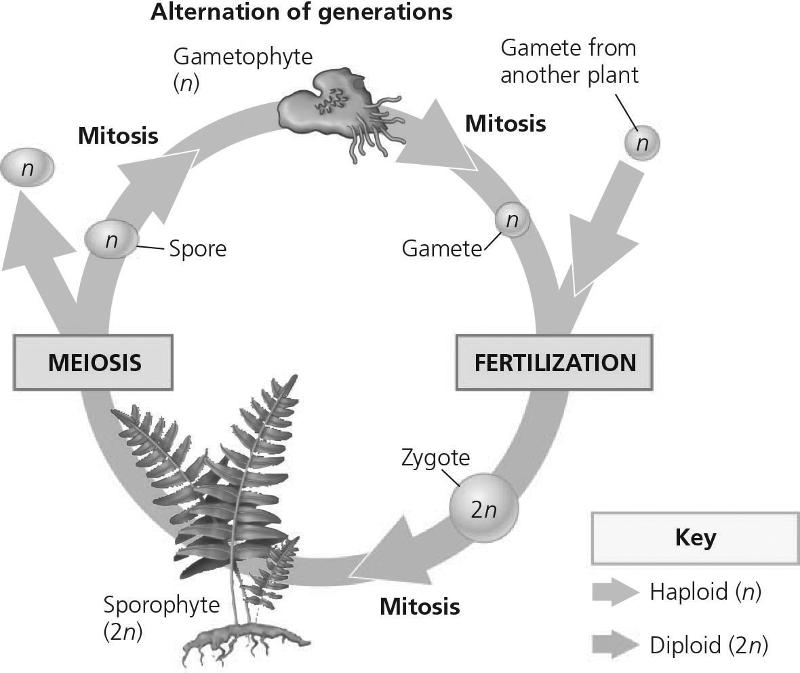
In the figure, which number produces haploid gametes by mitosis?
- A) 1
- B) 2
- C) 3
- D) 4
A
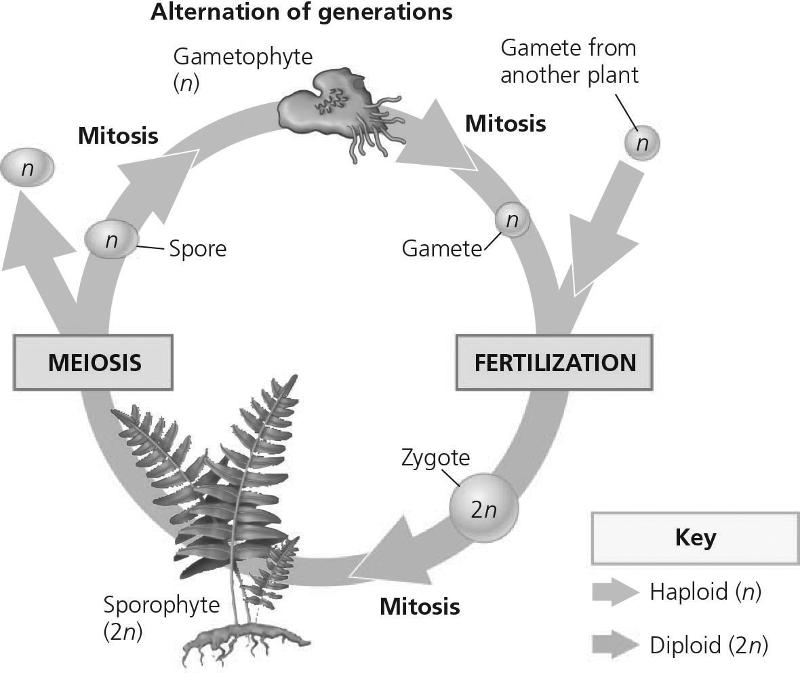
In the figure, which structure produces haploid spores by meiosis?
- A) 1
- B) 2
- C) 3
- D) 4
C
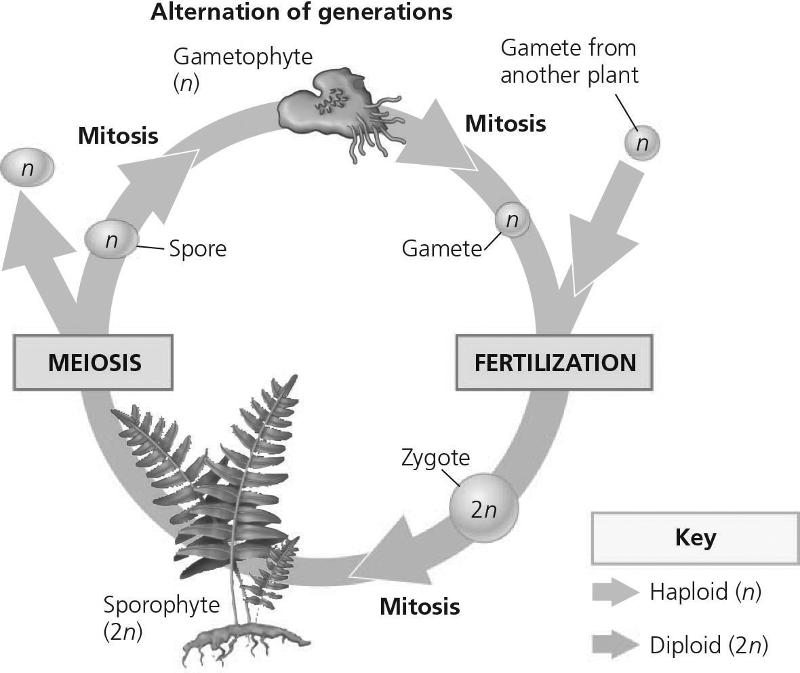
Meiosis is most likely to be represented by which number?
- A) 4
- B) 5
- C) 6
- D) 2
B
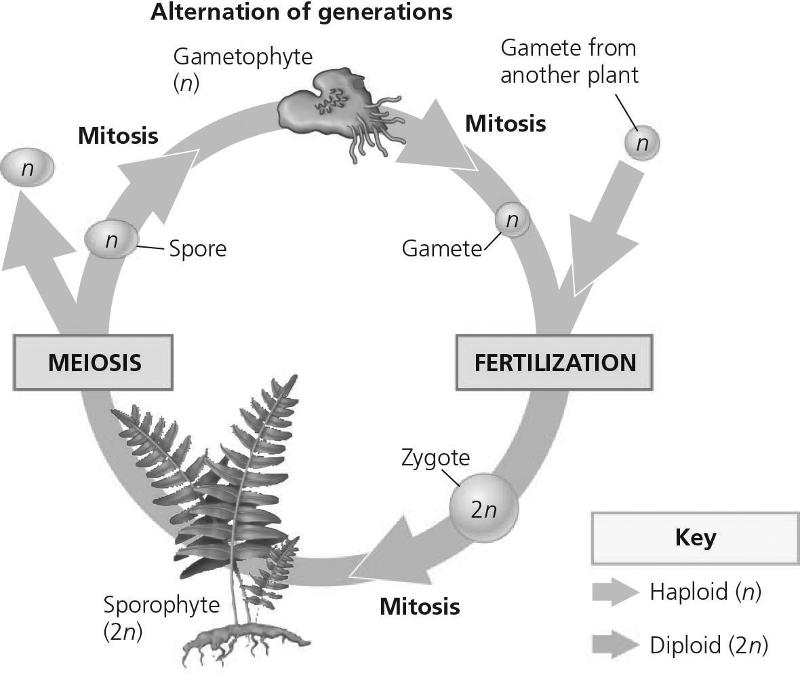
What describes the product of number 2?
- A) a haploid gametophyte
- B) a diploid gametophyte
- C) a haploid sporophyte
- D) a diploid sporophyte
D
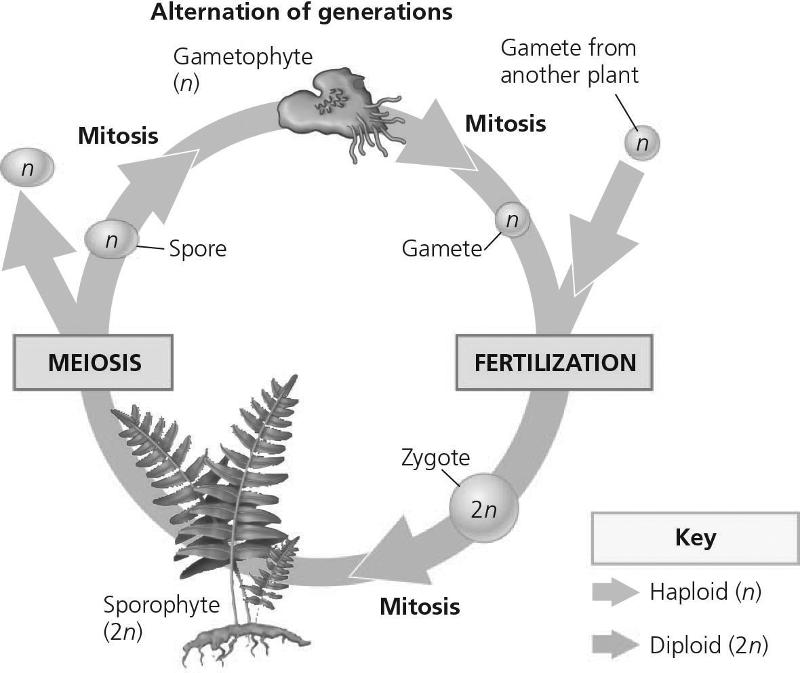
In the figure, what are the processes for numbers 4, 5, and 6, respectively?
- A) nuclear fission, meiosis, binary fission
- B) mitosis, meiosis, binary fission
- C) mitosis, meiosis, fertilization
- D) fertilization, mitosis, meiosis
C
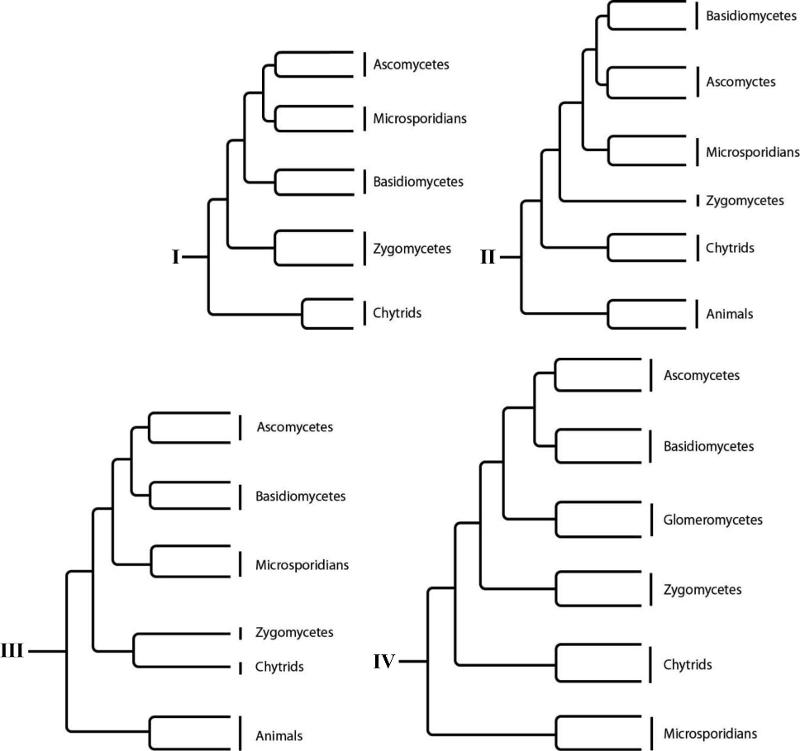
Which tree depicts all of the currently recognized major groups of fungi?
- A) I
- B) II
- C) III
- D) IV
C
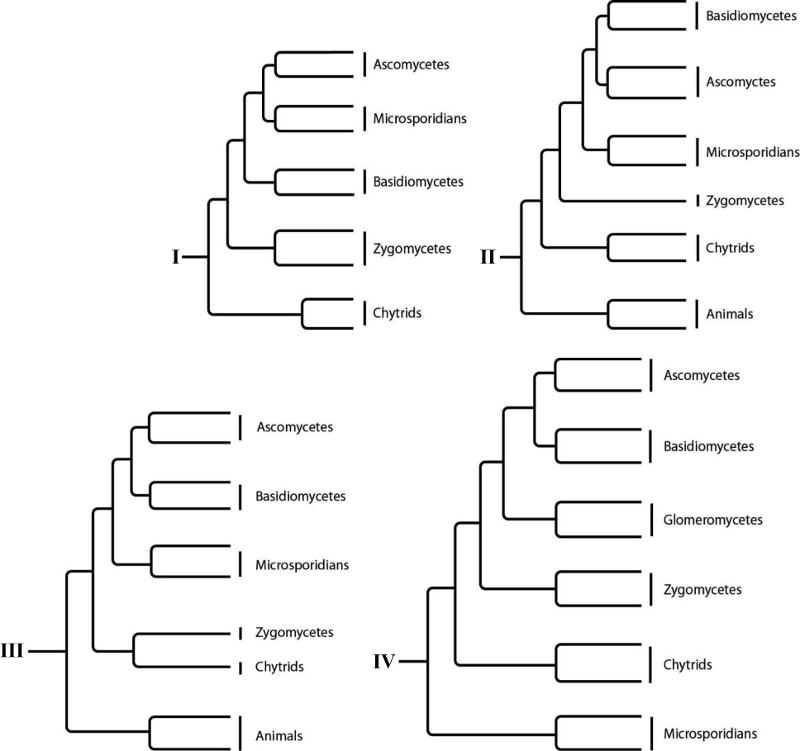
Which tree depicts the closest relationship between zygomycetes and chytrids?
- A) I
- B) II
- C) III
- D) IV
C
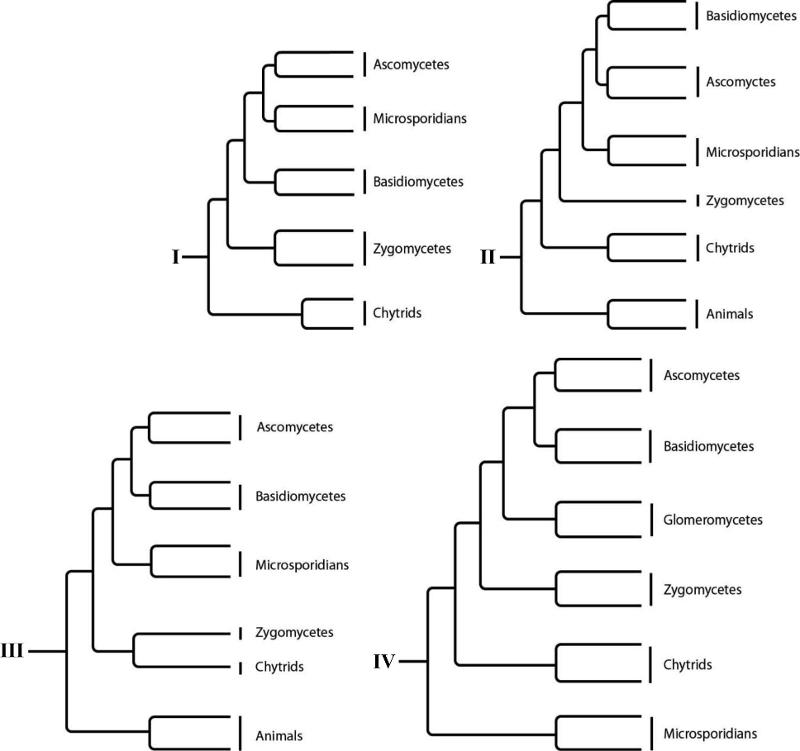
In phylogenetic tree I, which group of organisms is most directly related to the common ancestor of the tree?
- A) zygomycetes
- B) basidiomycetes
- C) ascomycetes
- D) chytrids
D

What is true of the phylogenetic tree in the figure?
- It depicts uncertainty about whether the bryophytes or the vascular plants evolved first.
- It is hypothetical.
- It shows that ferns are the closest living relatives to the seed plants.
- It indicates that seeds are a shared ancestral character of all vascular plants.
- A) 1 only
- B) 2 only
- C) 3 and 4 only
- D) 1 and 3 only
B
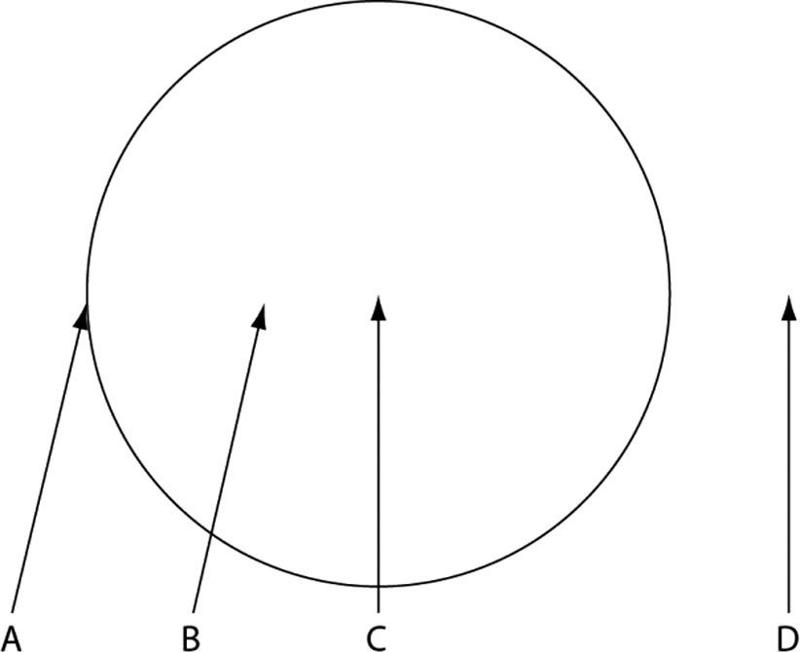
1) What is the most probable location of the oldest portion of this mycelium?
- A) A
- B) B
- C) C
- D) D
C